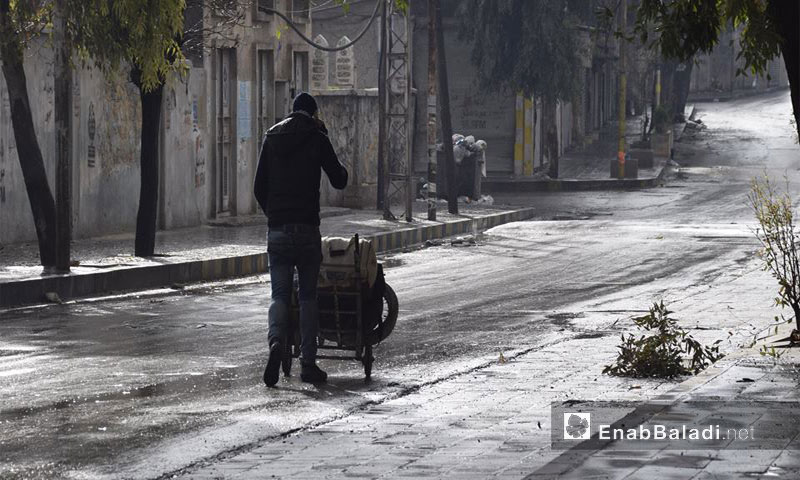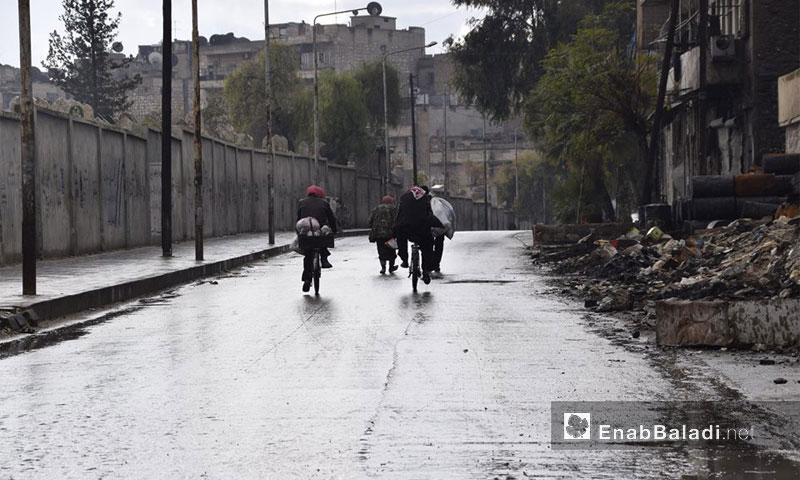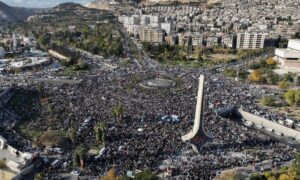Enab Baladi
On 23 June 2012, the entrance of the deceased Abdul Kader al-Saleh with his comrades in the “Free Syrian Army” into Aleppo surprised the residents of Hananu Residence. The FSA took control of the neighborhood and several other neighborhoods nearby and the regime lost half the city in a matter of days. On 23 November 2016, the regime turned the tables – their forces and militias took over the same neighborhood in a matter of two days and managed to take control of half the opposition neighborhoods in a few days.
Ten days of control over the eastern neighborhoods of Aleppo were sufficient to drastically alter the faultlines in the city after four years of stable lines of division between the eastern and western parts. The regime forces and their allies inflicted heavy field losses on the opposition, and the opposition appeared helpless before the enemy’s attacks. Neighborhoods surrendered one after the other, and thousands of civilians were forced to migrate to regime areas.
It is “the end of Aleppo”, as some Twitter users described it. No one predicted the horrors the besieged people of eastern Aleppo would witness. Hopes of victory were high, increasing with every shot fired by the southern fighters, but they were soon destroyed. Al-Assad, supported by Russia and Iran, achieved some of his goals by storming the eastern neighborhoods of the city, his fighters and mercenaries taking over the whole area. Aleppo was returned to the fold after its eastern part rebelled against the regime.
How Did Al-Assad and His Allies Prepare to Regain Eastern Aleppo?
For two and a half years, the al-Assad forces steadily advanced on Aleppo’s outskirts to arrive at their desired result today. Their plan began with regaining control of the industrial al-Sheikh Najar area in the eastern axis of the city in June 2014 then slowly moving north. They continued their attempts to advance along the eastern and northern fronts in order to lay siege to Aleppo.
At the beginning of 2015, the al-Assad forces advanced noticeably by opening the al-Sheikh Najar route to Sayfat then Bashkoyi north of the city. The regime’s plans became clear at that time, as they aimed to take control of the vital northern Castello Road, which connects the city of Aleppo to its northern and western rural outskirts and the border with Turkey.
Operations along this axis continued for over a year until the al-Assad forces managed to gain control of the villages of Hiylan, Rtyan, Hardatyin and Marset al-Khan, reaching Mayir in February 2016. The regime forces managed to partially break the siege on the pro-regime villages of Nubl and al-Zahraa. At the same time, Kurdish forces took control of the city of Tel Rifaat, Menagh military airbase and several neighboring villages, which meant that the two main roads connecting Aleppo city to the border with Turkey were cut off.
The regime and its Russians and Iranian allies managed to besiege the eastern neighborhoods of Aleppo, launching a new phase of the conflict with the aim of taking control of the al-Malah territory overlooking Castello Road, which they managed to do in June 2016. The operations continued, with the al-Assad forces gaining control of parts of the road in mid-June. Aleppo has been under siege since that time.
On 28 June, the regime forces entered Bani Zaid neighborhood, which borders the Castello Road along the northern axis of Aleppo. It is the first area the al-Assad forces regained since the opposition entered the city in 2012. Battles continued on that axis until the end of September 2016 when the regime forces tightened their control on the village of Hindrat, al-Shakif factory, thus gaining complete control of the Castello Road and the areas surrounding it.
The southern and south-eastern fronts of Aleppo remained quiet since the al-Assad forces took control of the city of al-Safirat and its rural outskirts in October 2013. These forces returned with extensive Iranian support to launch new battles in the area in October 2015, managing to gain control of opposition areas starting with the village of al-Wadihi that borders Aleppo city to reach the village of al-Hadar among others.
These forces expanded their operations on the south-eastern front to break the siege imposed on Kuweires Military Airbase in November 2015, and subsequently moved eastwards, stopping 11 kilometers south of the city of al-Bab.
The al-Assad forces and their militias achieved all this along Aleppo city’s three axes over the course of 24 months, encircling the eastern neighborhoods by targeting the area from the east and south, and besieging it by controlling the only road going north.
“Some of the militias participating in the battle for Aleppo
The Syrian regime has depended on armed militias, most of which are sectarian in nature, to fight against the opposition factions in Aleppo since 2015. Here we mention the names of 17 militias, most of which belong to the Shiite sect and come from six different countries other than the local and mixed militias.
Foreign Militias:
“Abu Al-Fadhal Al-Abbas” (Iraqi), “Al Beit” (Iraqi), “Al-Najba” (Iraqi), “Sayyid Al-Shuhada” (Iraqi), “Badr” (Iraqi), “Hezbollah” (Iraqi), “Al-Quds” (Palestinian), “Fatemiyoun” (Afghan), “Zainebiyoun” (Pakistani), “Hezbollah” (Lebanese), “Basij” (Iranian), “65th Airborne Special Forces Brigade” (The Green Hats) (Iranian).
Local And Mixed Militias: “National Defense” (local), “Suqur Al-Sahra” (local), “Al-Fuhud” (local), “Al-Bakr” (Syrian-Iraqi), the “Storm Eagles” (Syrian Social Nationalist Party which includes different nationalities).
During battles in recent days, the al-Assad forces and their militias united with the Kurdish People’s Defense Units and “Asayisha” forces, the two military wings of the Democratic Union Party, the founders of the Autonomous Administration in northern and north-east Syria.
Failed Battles Exhaust the Opposition and Residents
The opposition did not stand idly by as the regime attacked. They fought twice to break the siege on the eastern neighborhoods of Aleppo but failed on both attempts. The failure impacted negatively on their position on the ground and contributed to weakening the military and organizational structure of the factions, which are exhausted and fragmented following the defeats.
On 31 June 2016, Jaish al-Fateh factions, which have popular support in Aleppo and its countryside, called on civilians to burn tires in order to spread smoke and prevent warplanes from obstructing the operation. The military operation opened a gap in the al-Ramouseh axis south of Aleppo, reaching al-Sheikh Saeed neighborhood with the aim of ending the siege imposed on the eastern neighborhoods.
The resounding victory and continued collapse of the al-Assad forces’ defenses resulted in the latter losing the military academy in the area of al-Ramouseh, al-Ramouseh neighborhood, the southern hills reaching al-Hikmet school and the “1070 Apartments” area that is part of al-Hamadaniya neighborhood. This success enabled a first aid convoy to enter the city through al-Ramouseh crossing in the first week of August 2016, although with great difficulty due to regime warplanes targeting the route.
The victory chants did not last long, as it became clear in the following weeks that this axis would not be the key to ending the siege on eastern Aleppo. The al-Assad forces, Russia and Iran would not allow humanitarian aid or weapons to continue to move along this route. Aerial strikes began to inflict severe damage on the Jaish al-Fateh factions together with consecutive regime attacks by land, which managed to close the gap in September 2016 and return the military academies and vast parts of al-Ramouseh neighborhood to regime control. The opposition only managed to maintain their control over a few hills and the “1070 Apartments” area at that time.
On 28 September 2016, Jaish al-Fateh, supported by the Fateh Halab factions, began a new battle on a different front with the aim of breaking the siege on the eastern neighborhoods. The plan included gaining control of al-Assad suburb and the village of Minyan, strengthening their position in the “3000 Apartments” area and taking control of al-Hamadaniya neighborhood and New Aleppo neighborhood including the “military academy.” The opposition would thus take control of parts of western Aleppo and break the siege on the eastern neighborhoods from the Salah el-Din neighborhood.
The battle did not last long despite the opposition’s victory in the first phase as it gained control of al-Assad suburb and the neighboring village of Minyan, which gave the impression that they were able to gain control of all of Aleppo if al-Hamadaniya, New Aleppo and the military academy – considered the al-Assad forces’ fortifications in the city – fell.
On 12 November, the al-Assad forces prepared to regain what they had lost in the previous battles, and the situation returned to what it had been prior to 31 June 2016. All opportunities to break the siege on the city from the southern front were lost and the eastern neighborhoods entered a new, more violent and tragic phase, according to local and international human rights and humanitarian organizations.
The opposition failed to rescue the besieged people of Aleppo and they committed several military mistakes, the most important being the lack of coordination between the 15 factions that participated in the two battles. Perhaps the most influential was the decision to gain control of areas but then not defend them, a move that was repeated on several instances, according to a field officer in Jaish al-Fateh who expressed his regret over what had happened, “We lost 700 fighters from among the best of our attackers in two months, and the factions were exhausted without achieving any real accomplishment.”
Situation on the Ground After Taking the Northern Part of Eastern Aleppo
“The United Nations Envoy to Syria Staffan De Mistura’s initiative dictates facilitating the evacuation of fighters of the Fateh al-Sham front from the east of the city of Aleppo towards the north in return for stopping the bombing and fighting, which would allow aid to reach the besieged population. Since it was proposed, Russia announced its willingness to convince the Syrian regime of the initiative on the condition that the Fateh al-Sham fighters leave.”
After the opposition’s failure in its last battle, the al-Assad forces launched their most violent attack on the city of Aleppo. The attacks resulted in the death of more than 600 civilians, according to the National Defense, and destroyed more buildings and infrastructure than before. As part of the attacks, the al-Assad forces and their militias launched attacks from the eastern side to take control of al-Zuhur hill overlooking Hananu neighborhood on 21 November 2016.
On the morning of 23 November, the al-Assad forces stormed Hananu neighborhood and gained complete control of it by 26 November. The forces expanded towards the surrounding neighborhoods with clear, but unofficial, coordination with the Kurdish ‘People’s Protection Units’, which took over six neighborhoods after the opposition factions withdrew from them, including Bastan al-Basha, Ayn al-Tel, al-Sheikh Faris and al-Zaytunah.
The al-Assad forces and their foreign and local militias took control of the neighborhoods of Hananu residences, al-Haidarya, al-Sakhur, Suleiman al-Halabi, Jabal Badro, al-Intharat, Ayn al-Tel, al-Arad al-Hamra and al-Sheikh Khader on 28 November. The al-Assad forces continued their military pressure and consecutive strikes, benefiting from the collapse of the opposition’s ranks, and on 3 December, the regime forces took control of the neighborhoods of Tariq al-Bab, Masaken al-Shabab, al-Hilwanet and Karm al-Jazmati. Fighting continues in Karm al-Miysar neighborhood at the time of writing.
Al-Assad forces have taken control of around 20 kilometers squared of the eastern neighborhoods of Aleppo and 20 kilometers remain under opposition control. The areas under opposition control are restricted to the south and center of the city, with the possibility of the regime advancing to Karm al-Miysar and Karm al-Tarab for its forces to reach the neighborhoods of al-Qatraji, al-Shaar and al-Marjet.
The opposition factions managed to block the attack on the al-Sheikh Saeed neighborhood from the southern side. The al-Assad forces and their militias then attacked along the al-Azizet and al-Shurta Hill front with the aim of gaining control of the al-Sheikh Lutfi neighborhood that borders Bab al-Nirab neighborhood on the south eastern front, but did not managed to achieve any change in control along this front.
Jaish Halab: The Opposition Seeks Solutions
The first attempts to form a united military opposition body in Syria began in 2014, when 90 opposition factions announced a new initiative with the title, “And They Persevered.” An accord to form a “Syrian Revolutionary Leadership Council” was proposed but according to observers the initiative has failed to achieve its goal until today.
In Aleppo, a number of factions formed the first joint entity, represented in the Fateh Halab operation room in March 2015, which aimed at taking control of the western neighborhoods of the city that are all still under the control of the al-Assad forces. The number of factions later rose to 31 including Nour al-Din al-Zenki Movement, Al-Sham Front, Ahrar al-Sham Movement, Jaish al-Islam, Al-Sham Legion, Abu Amara Brigade and Suqur al-Jabal Legion.
As part of the operation room, these factions executed hundreds of operations against the al-Assad forces in Aleppo city and its outskirts. These factions eventually formed the “Aleppo Command Council” on 14 November to include all the factions operating in the city in light of disputes between some of the factions. These disputes took center stage with the escalation of the battles close to the city while the residents accused the factions of letting them down.
At the start of December, the largest formation so far was created, called “Jaish Halab”, in a bid to rescue the stricken city. The formation included Al-Sham Front, Ahrar al-Sham and the Nour al-Din al-Zenki Movement alongside several other factions under the leadership of Abu Abdulrahman Nour from the Al-Sham Front. The majority of Nour’s work has focused on stopping the al-Assad forces’ and their militias’ attacks on the al-Sheikh Saeed neighborhood from the southern front to eastern Aleppo, as well as regaining some areas that the al-Assad forces have advanced towards in the nearby al-Sakan al-Shababi area.
After forming Jaish Halab, Sergey Lavrov, the Russian Minister of Foreign Affairs, confirmed that Russia has accepted the De Mistura initiative, which requires the “armed fighters” to leave Aleppo, “despite the lack of clarity of the idea,” as he put it. He commented, “Jaish Halab is an attempt to rename Fateh al-Sham to enable it to avoid the punishment it deserves.”
The Russian discourse did not change after the emergence of the new formation, and it confirmed its forces’ continued efforts to “cleanse” the city of Aleppo from “terrorist organizations”. Lavrov estimated the number of fighters in eastern Aleppo to be around 7500 fighters, “1500 fighters from al-Nusra Front, and around 6000 other fighters belonging to different groups that are under al-Nusra’s control.”
Enab Baladi spoke to Yasir Ibrahim al-Yusef, a member of the political office of the Nour al-Din al-Zenki Movement, who said, “Jaish Halab should be replicated in all other areas and frontlines, to reach the point of forming a free national army controlled by the people and protecting them, which would only use its weapons to fend off enemies.” He confirmed that, “Jaish Halab will later expand to Aleppo’s countryside to reach the northern national army.”
Al-Yusef described JaishHalab as, “The defensive cordon and a true added-value to the revolution in Aleppo,” clarifying, “The ‘Jaish’ means a united revolution and force in the city, and a unified base means unified decision-making.”
Responding to the criticisms residents and activists have made of the city’s factions, al-Yusef did not deny their responsibility and said that everyone is responsible, “We are all to blame and we are a;; excused at the same time.” He said that what had happened in Aleppo in the past week does not require justification but positive work to salvage what can be saved, “The battle is not between an army and another army, but against armies, militias and major powers that have united to force the Syrian people to yield but we will never compromise and we will resist with whatever strength we have even though we are up against Iran and Russia.”
Enab Baladi tried to reach more than one military commander in Aleppo including the leader of the al-Mujahidin Army, Lieutenant Colonel Mohammad Juma Bakur (Abu Bakir), to ascertain their views regarding the possible solutions to the current situation but our intermediaries informed us that the commanders were busy dealing with the threats the city is currently experiencing.
Aid Is Paralyzed… Demands to Transfer the Issue to the General Assembly
The United Nations plan to get humanitarian aid into eastern Aleppo receives a large amount of interest from western media amid political tension and accusations regarding the obstacles preventing the entrance of the aid. The situation on the ground in Aleppo shows the regime and its Iranian and Russian allies’ determination to take control of the remaining neighborhoods of eastern Aleppo. The military option gives the impression that the entry of aid is almost impossible at present.
Jan Egeland, the United Nations Senior Advisor, is still waiting for the greenlight from Russia and al-Assad after the opposition factions agreed weeks ago to the international organization’s plan to deliver humanitarian aid and evacuate patients to nearby hospitals. Russia, however, claims that circumstances are not suitable at present for launching the United Nations’ humanitarian plan in eastern Aleppo.
The entry of aid requires speeding up the efforts to end the battles in Aleppo, according to a shared vision summarized in a telephone conversation between the Turkish President Recep Tayyip Erdogan and his Russian counterpart, Vladimir Putin, on 30 November. However, Washington doubts the possibility of opening safe roads to deliver aid.
On 1 December, the US State Department announced that Washington is taking into consideration the violence in Aleppo city, confirming that, “It is difficult to rely on Russian announcements regarding the possibility of establishing safe roads for delivering humanitarian aid to Aleppo.”
International organizations around the world criticized the International Security Council’s actions regarding the humanitarian crisis in Aleppo, amid warnings that its imminent surrender “will make it another Rwanda or Srebrenica”. A total of 223 organizations from 45 countries launched statements, the most prominent being Human Rights Watch, Save the Children and Care International, along with 63 Syrian organizations.
Doctor Simon Adams, the executive director of the Global Center For Responsibility To Protect, considered that Aleppo is turning into another Rwanda or Srebrenica, “We are witnessing international laxity in facing the extermination of humans.” He added, “In light of the shameful state of paralysis the Security Council has reached, it remains for the members of the General Assembly to practice their authority and call for an exceptional emergency session to demand an immediate end to attacks on civilians and hold the perpetrators of war crimes and crimes against humanity in Syria responsible.”
Ahmad Tarqaji, a member of the Syrian American Medical Association, called for action to be taken “to face the depravity and lack of respect for basic standards regarding what is happening Aleppo.” Eduarda Hamann, coordinator of a peace building program at the Igarape center in Brazil, said that the current situation in Aleppo “is a real test for the international system. The international community cannot hesitate in the face of the tens of thousands of violent forced evacuations against Syrians.”
“According to the United Nations Charter, the General Assembly can take decisions in the place of the Security Council in the event that the Council has demonstrated its inability to maintain international peace and security, but the General Assembly’s authority remains limited. Canada called invoked this principle during the Korean crisis in 1950, the war in Congo in 1960 and the Russian invasion of Afghanistan in 1980.”
Human Rights Watch recently published a report documenting “war crimes” executed by the al-Assad forces supported by Russia in September and October 2016. According to the report, 440 civilians, among them 90 children, were killed in these attacks. The organizations demanded member states of the United Nations to respect the “United For Peace” principle and act to immediately “stop the Security Council’s paralysis and stop the horrors in Aleppo.”
Other countries have taken action regarding Aleppo, including Canada, which launched an initiative and gained the support of 73 countries to demand an emergency session of the United Nations General Assembly.
International Meetings and Conferences… Aimed at Peace or Evacuation?
Far from the battles on the ground, international meetings and gatherings continue to discuss Aleppo, with the Security Council voting on 5 December on a joint draft statement proposed by Egypt, New Zealand and Spain calling for a ceasefire in Aleppo and allowing the entry of humanitarian aid. Meetings were also being held in Ankara between representatives of the Russian Ministry of Defense and representatives of some of the opposition factions in Aleppo city.
“The draft statement that the Security Council will vote on does not include battles against the “Islamic State of Iraq and Syria” or Fateh al-Sham Front or any other group the Council classifies as a terrorist organization.”
No decisions or results came out of those meetings until 3 December. While the opposition say \that Russia is purposely dragging its feet in these meetings, experts predict that work will continue to reach an agreement that will reduce the intensity of the fighting and allow groups of fighters to leave Aleppo in conjunction with the Paris meeting for the “Friends of Syria” group on 10 December.
An agreement for fighters to leave for Idlib raises the possibility of emptying Aleppo of fighters, especially as Russia considers the Daraya scenario as an example that could be replicated in other towns and cities controlled by the opposition in Syria. Experts, however, doubt the possibility of this scenario happening in Aleppo as it did in the towns of eastern al-Ghouta in Damascus’ countryside.
Yasir al-Yusef, a member of the Al-Zenki Movement political bureau, sees the Turkish-Russian discussions in Ankara as being aimed at limiting the violence and getting medical and humanitarian assistance into Aleppo. He pointed out, “The issue is being exaggerated in the media on the basis that these are direct negotiations with the opposition, but they are not. Our discussions are with the Turkish side only, and the revolutionary factions play an important role in securing the potential convoys and securing delivery routes for assistance.”
Regarding the possibility of Aleppo being emptied of its fighters, al-Yusef said, “The regime’s plans and those of its Russian and Iran allies have become clear to all with the adoption of the ‘starve or surrender’ policy, alongside the policies of displacement to change the demographic composition, which they have managed to implement in some areas in the South. But Aleppo, with its revolutionary bodies in the city and countryside and the determination of its people, will break the arrogance of these tyrants to show how flesh and blood will defeat iron and fire.”
Al-Yusef sees no possibility of executing any initiatives at present, “We are forced to resist and defend ourselves and our people. The revolution is not a street here or a neighborhood there but the will to change, which grows with each drop of blood.” He concluded by asserting, “We have achieved what we can until now and we do not depend on any international or regional efforts to break the siege.”
Some experts see that the remaining eastern neighborhoods will face the same fate as the old neighborhoods of Homs when they were emptied of their fighters by the al-Assad forces and Iran two and a half years ago. The comparison comes especially as thousands of families have already been forced to leave for western Aleppo and thousands of others are preparing to leave in order to escape death, which awaits them at every corner. Others insist that this was just one unsuccessful round and that the Syrian revolution will rise again despite all the difficulties.
if you think the article contain wrong information or you have additional details Send Correction
النسخة العربية من المقال
-
Follow us :


















 A
A
A
A
A
A









 More In-Depth
More In-Depth